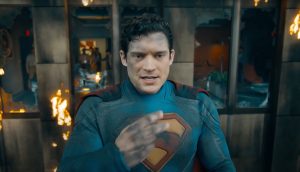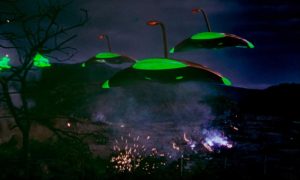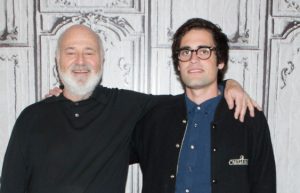
Is there any movie opinion more wrong-headed than saying that Godzilla isn’t my Godzilla? Sure, you might prefer the serious allegorical Godzilla from the 1954 movie or, more recently, Shin Godzilla and Godzilla Minus One. Or you might like the goofier Godzilla from Godzilla vs. Gigan and the newest film, Godzilla x Kong: The New Empire. Heck, it is absolutely okay if the American Iguana monster Zilla is your jam.
The only thing that’s unacceptable, that’s absolutely dumb and worthless, is saying that a particular movie doesn’t understand Godzilla. A movie may botch everything else around the giant lizard monster, as happens often in the United States, but the lizard always works. Not only would every movie be improved by the inclusion of a giant fire-breathing monster, but the King of the Monsters fits in a wide range of movies, making him (or her!) pop culture’s most versatile star.
The Ongoing Evolution of Godzilla Movies
For all the reverence of Ishirō Honda’s original film, the reign of serious Godzilla didn’t last too long. Yes, that first 1954 film refracted the horror of the American attacks on Japan through a giant monster lens. But the 1956 U.S. recut Godzilla, King of the Monsters! cut out the bleaker elements and left behind just a man in a rubber suit. Lest one put the blame on American audiences for being dumb, though, the Japanese movies quickly followed suit. Godzilla battled Anguirus in his second entry, Godzilla Rides Again (1955), and then crossed over with an American hit for his third outing, King Kong vs. Godzilla (1962). Almost immediately, the movies became a delivery method for introducing new giant monsters for him to slug.
This isn’t to say that the movies completely drop Big G’s allegorical elements. Godzilla vs. Hedorah (1971) pits him against a living smog monster, setting the blueprint for the Legendary movies in the United States. But the films downplayed those themes in favor of spectacle and fun.
Nothing illustrates that shift better than Godzilla’s shift to father figure in Son of Godzilla (1967). That film introduced Minilla, a younger member of the lizard species who pals around with big green for a few films. Some might be tempted to dismiss Minilla as a product of the ’60s, but the franchise keeps coming back to him. Godzilla vs. Mechagodzilla II (1993) reimagines the character as Baby Godzilla, aka Godzilla Junior, and then Minilla joins the parade of cameos in 2004’s Godzilla Final Wars and, more importantly, played a main roll in the kid’s web series Monster Puppet Show Godziban (2019-2023).
While the Legendary films began with the plodding horror movie Godzilla (2014), the franchise soon took a turn for the goofy, to the point that he’s now in a buddy action movie with Godzilla x King: The New Empire (2024). This neon-colored entry comes on the heels of Godzilla Minus One (2023), a Japanese entry that deals with PTSD and anger at Japan’s role in World War II.
In short, Godzilla movies have always been changing. But Godzilla himself has not.
The Many Moods of Godzilla
The only thing more surprising than the range of Godzilla’s movies is just how great Big G is in them.
Literal decades of Godzilla stomping on toy tanks, accompanied with jokes by everyone from the Mystery Science Theater 3000 gang to your uncle who thinks bad dubbing is hilarious did nothing to diminish the sheer terror of his arrival in Shin Godzilla. Whatever one thinks of the quality of the Legendary movies, it’s hard not to cheer when G-Man throws down with Scylla at the start of The New Empire.
Part of this success comes from the simplicity of Godzilla’s purpose as a character. At a fundamental level, Godzilla is a beast who lumbers into an area, breaths fire, and smashes things. This isn’t to diminish the depth of character brought by performers such as Haruo Nakajima, who wore the suit for the first twelve movies. Rather it’s a testament to Nakajima’s skills as an actor that he kept Godzilla consistent across movies with wildly differing tones.
Time and again, the movies and extended universe material demonstrate that you can do whatever you want around Godzilla, but Godzilla remains Godzilla. Scream in terror at his arrival? Cheer because he’s about to pound some other monster? Drive hard to the net? It doesn’t matter. Godzilla is unchanged.
Thanks to his single-minded focus, the Big G can carry many cultural signifiers without being defined or overwhelmed by any of them. When, for example, Godzilla Minus One builds to its first atomic breath scene, viewers understand the weight of what they’re about to watch, an echo of one of the worst atrocities in human history. When not even six months later, the camera zooms into Godzilla’s glowing blue eye at the start of The New Empire, audiences cheer for the throw-down they’re about to enjoy.
As these examples demonstrate, Big G offers storytellers an incredible range of possibilities, even more so than other flexible characters, such as Batman or James Bond. Whatever story you want to tell can be done with Godzilla in it, and probably improved.
Godzilla Unchanged
In a key scene from The New Empire, Godzilla channels his inner Mega Man and receives an influx of power after defeating a fellow kaiju. In place of his traditional blue atomic hue, Godzilla starts to glow magenta, better matching the film’s neon aesthetic.
The pink power version of Godzilla featured heavily in The New Empire‘s promotional campaign, much to the chagrin of some fans. Those same fans grew even more annoyed upon watching The New Empire and finding that the movie largely relegates Godzilla to playing Kong’s sidekick.
And yet, every single time Godzilla charges on the screen is awesome. He smacks around his enemies with all the energy of a professional wrestler and we cheer every time. But the next time that a movie uses Godzilla as an allegory to a world-destroying existential threat, we’ll scream in horror. And when Godzilla finds another lizard tyke to protect, we’ll sigh in admiration.
Because it doesn’t matter what you do. Godzilla is always Godzilla, the King of the Monsters.
Godzilla x Kong: The New Empire is now in theaters.
The post Let’s Face It, Godzilla Is Pop Culture’s Most Versatile Star appeared first on Den of Geek.










